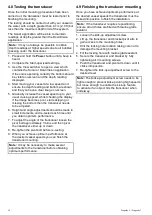
3.9 Selecting a location for the display
General location requirements
When selecting a location for the unit it is important
to consider a number of factors.
Ventilation requirements
To provide adequate airlow:
• Ensure that equipment is mounted in a
compartment of suitable size.
• Ensure that ventilation holes are not obstructed.
• Ensure adequate separation of equipment.
Mounting surface requirements
Ensure units are adequately supported on a secure
surface. Do NOT mount units or cut holes in places
which may damage the structure of the vessel.
Cable routing requirements
Ensure the unit is mounted in a location which allows
proper routing and connection of cables:
• Minimum cable bend radius of 100 mm (3.94 in) is
required unless otherwise stated.
• Use cable supports to prevent stress on
connectors.
Electrical interference
Select a location that is far enough away from
devices that may cause interference, such as
motors, generators and radio transmitters/receivers.
GPS location requirements
In addition to general guidelines concerning the
location of marine electronics, there are a number
of environmental factors to consider when installing
equipment with an internal GPS antenna.
Mounting location
•
Above Decks mounting:
It is recommended that the display is mounted
above decks as this provides optimal GPS
performance.
•
Below Decks mounting:
GPS performance may be less effective when
mounted below decks.
Vessel construction
The construction of your vessel can have an impact
on GPS performance. For example, the proximity
of heavy structures such as a structural bulkhead,
or the interior of larger vessels may result in a
reduced GPS signal. Before locating equipment
with an internal GPS antenna below decks, seek
professional assistance.
Prevailing conditions
The weather and location of the vessel can affect the
GPS performance. Typically calm clear conditions
provide for a more accurate GPS ix. Vessels at
extreme northerly or southerly latitudes may also
receive a weaker GPS signal. GPS antenna mounted
below decks will be more susceptible to performance
issues related to the prevailing conditions.
Compass safe distance
To prevent potential interference with the vessel's
magnetic compasses, ensure an adequate distance
is maintained from the display.
When choosing a suitable location for the display
you should aim to maintain the maximum possible
distance between the display and any compasses.
Typically this distance should be at least 1 m (3 ft)
in all directions. However for some smaller vessels
it may not be possible to locate the display this far
away from a compass. In this situation, the following
igures provide the minimum safe distance that
should be maintained between the display and any
compasses.
Item
Compass
position in
relation to
display
Minimum safe
distance from
display
1
Top
200 mm (7.87 in.)
2
Rear
500 mm (19.7 in.)
3
Right-hand side
350 mm (13.8 in.)
4
Underside
300 mm (11.8 in.)
5
Front
700 mm (27.5 in.)
6
Left-hand side
250 mm (9.84 in.)
Viewing angle considerations
As display contrast and color are affected by the
viewing angle, If you intend to surface mount the
display, it is recommended that you temporarily
power up the display when planning the installation,
to enable you to identify which location gives the
optimum viewing angle.
22
Dragonly 6 / Dragonly 7
Summary of Contents for Dragonfly 6
Page 2: ......
Page 4: ......
Page 24: ...24 Dragonly 6 Dragonly 7...
Page 82: ...82 Dragonly 6 Dragonly 7...
Page 96: ...96 Dragonly 6 Dragonly 7...
Page 104: ...104 Dragonly 6 Dragonly 7...
Page 108: ...108 Dragonly 6 Dragonly 7...
Page 112: ...112 Dragonly 6 Dragonly 7...
Page 115: ......
Page 116: ......





































